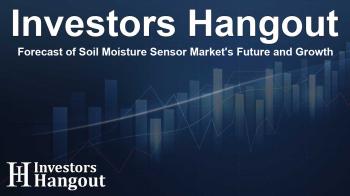Forecast of Soil Moisture Sensor Market's Future and Growth

Overview of the Soil Moisture Sensor Market
According to recent insights, the Soil Moisture Sensor Market is slated for remarkable growth in the coming years. This surge is primarily attributed to the relentless push for sustainability and conservation in agriculture. Recent evaluations have pegged the market's value at approximately USD 337 million in the recent past, with projections indicating it could escalate to USD 1124.30 million by the year 2032. This growth represents a compound annual growth rate (CAGR) of an impressive 14.33% during the forecast period spanning from 2024 to 2032.
Driving Forces Behind Market Growth
Global Population and Agricultural Needs
As the global population continues to climb, the demand for sustainable agricultural practices intensifies. Soil moisture sensors play a pivotal role in this landscape, enabling more efficient water usage and promoting environmental conservation. These sophisticated tools integrate seamlessly with automated irrigation systems, thereby minimizing manual labor while maximizing efficiency.
Technological Improvements Enhance Efficiency
Recent advancements in sensor technology, particularly with features like wireless connectivity and the Internet of Things (IoT), have been game changers. These innovations not only amplify the accuracy of moisture detection but also simplify overall agricultural practices. Research shows that more than 25% of the world's irrigated land is currently utilizing such technology, predominantly within the agriculture sector, which commands over 60% of market demand.
Market Segmentation by Sensor Type
The soil moisture sensor landscape is diverse, with various types like capacitive sensors, probes, and time domain transmissometry (TDT) sensors. Notably, tensiometers led the market in 2023, commanding a 32.06% share due to their reliability in providing accurate soil water potential readings. This segment's precision significantly aids farmers in optimizing irrigation practices and enhancing crop productivity.
Regional Insights into Market Trends
North America: A Front-Runner
In 2023, North America emerged as the leading region in the soil moisture sensor market. This dominance arises from the region's advanced agricultural practices and a strong inclination towards precision farming techniques aimed at water conservation. With a sizable market share of 38.02%, the need for soil moisture sensors is bolstered by substantial investments in agricultural innovations.
Growth Perspective in Asia Pacific
On the other hand, the Asia Pacific region is gearing up for rapid growth, propelled by governmental initiatives encouraging sustainable farming methods. Countries like India and China are witnessing significant upticks in the adoption of advanced irrigation technologies, which is contributing to a notable expansion in the soil moisture sensor market.
Application in Non-Agricultural Sectors
It's essential to acknowledge that soil moisture sensors are not confined to agriculture alone. Their application extends to landscaping, environmental monitoring, and other sectors, further diversifying the market. As societies increasingly value ecological preservation, the demand for such technologies will likely continue to rise.
Leading Players in the Soil Moisture Sensor Marketplace
Several companies stand out within this burgeoning market segment. Key players include:
- The Toro Company
- METER Group, Inc. USA
- Campbell Scientific, Inc.
- Stevens Water Monitoring Systems Inc.
- IMKO Micromodultechnik GmbH
- Irrometer Company, Inc.
- Delta-T Devices Ltd.
- GroPoint
- Sentek
- Spectrum Technologies, Inc.
- Acclima, Inc.
- Smartrek Technologies Inc
- Caipos GmbH
- Spiio
- Plaid Systems LLC
- Decagon Devices (now part of METER Group)
- AquaCheck USA
- Husqvarna Group
- Soil Scout Ltd.
- Gardena
Future Prospects and Innovations
Market Outlook
With the continual emergence of innovative technologies, the future of the soil moisture sensor market appears bright. The integration of advanced data analytics and connectivity will undoubtedly enhance the functionality and efficiency of these sensors in practical applications.
Conclusion
As we progress deeper into an era where sustainability is paramount, soil moisture sensors will serve as critical tools in the drive for optimized agriculture. By enhancing water management practices, these sensors are crucial for elevating agricultural productivity while ensuring conservation practices are upheld.
Frequently Asked Questions
What is the expected growth rate of the soil moisture sensor market?
The soil moisture sensor market is projected to grow at a CAGR of 14.33% from 2024 to 2032.
How do soil moisture sensors benefit agriculture?
These sensors help optimize water usage, reduce wastage, and improve crop yields through precise irrigation.
Which regions are leading in the soil moisture sensor market?
North America and the Asia Pacific are currently leading, with North America holding a significant market share due to advanced agricultural practices.
What types of sensors are commonly used in the market?
Common types include capacitance sensors, probes, TDT sensors, and tensiometers.
What applications do soil moisture sensors have beyond agriculture?
They are also used in landscaping, environmental monitoring, and various research applications.
About Investors Hangout
Investors Hangout is a leading online stock forum for financial discussion and learning, offering a wide range of free tools and resources. It draws in traders of all levels, who exchange market knowledge, investigate trading tactics, and keep an eye on industry developments in real time. Featuring financial articles, stock message boards, quotes, charts, company profiles, and live news updates. Through cooperative learning and a wealth of informational resources, it helps users from novices creating their first portfolios to experts honing their techniques. Join Investors Hangout today: https://investorshangout.com/
Disclaimer: The content of this article is solely for general informational purposes only; it does not represent legal, financial, or investment advice. Investors Hangout does not offer financial advice; the author is not a licensed financial advisor. Consult a qualified advisor before making any financial or investment decisions based on this article. The author's interpretation of publicly available data presented here; as a result, they should not be taken as advice to purchase, sell, or hold any securities mentioned or any other investments. If any of the material offered here is inaccurate, please contact us for corrections.
